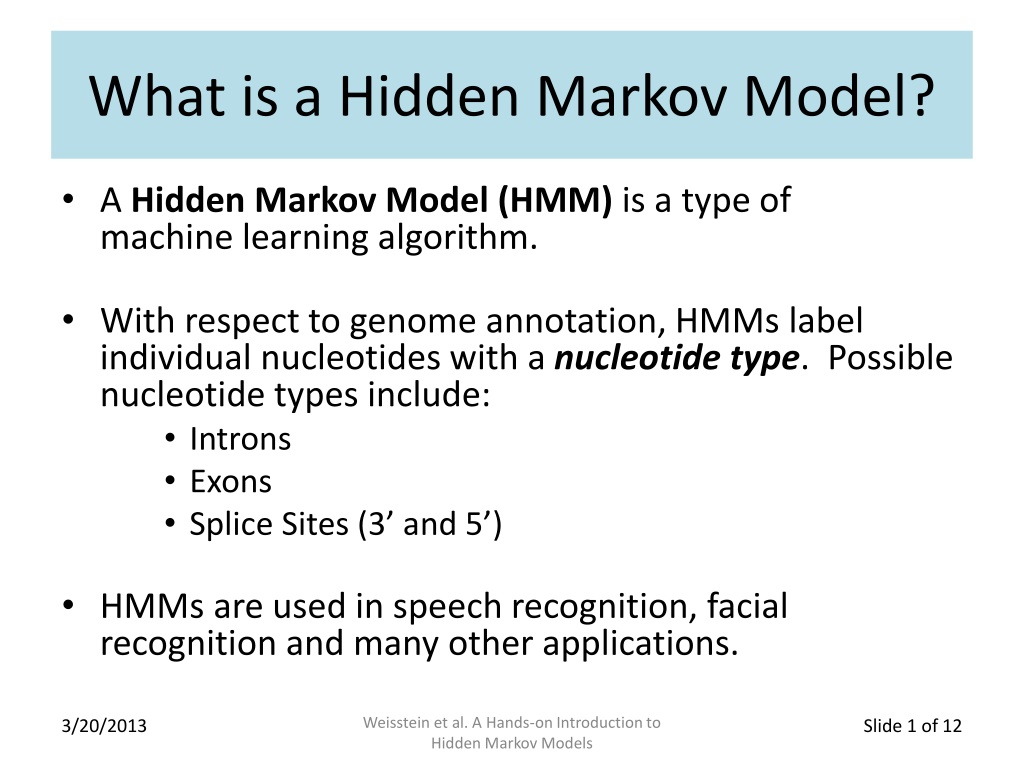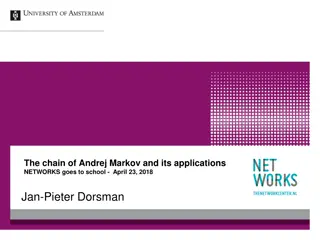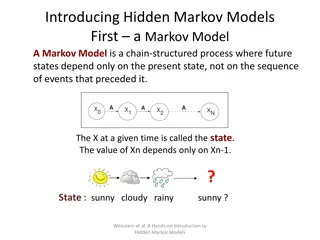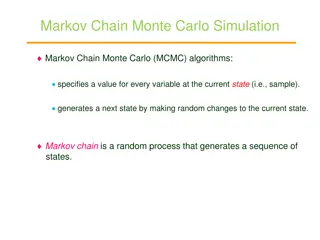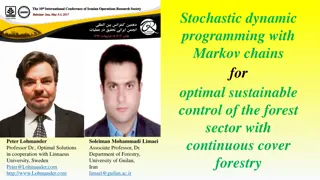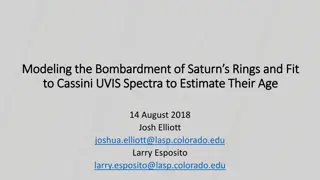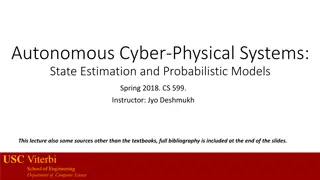What is a Hidden Markov Model?
Hidden Markov Models (HMMs) are versatile machine learning algorithms used in various applications such as genome annotation, speech recognition, and facial recognition. This model assigns nucleotide types to individual nucleotides and calculates transition and emission probabilities to infer hidden states. Learn about HMM features, state diagrams, nucleotide types, emission probabilities, and how HMMs determine correct splice sites based on probabilities.
Download Presentation

Please find below an Image/Link to download the presentation.
The content on the website is provided AS IS for your information and personal use only. It may not be sold, licensed, or shared on other websites without obtaining consent from the author.If you encounter any issues during the download, it is possible that the publisher has removed the file from their server.
You are allowed to download the files provided on this website for personal or commercial use, subject to the condition that they are used lawfully. All files are the property of their respective owners.
The content on the website is provided AS IS for your information and personal use only. It may not be sold, licensed, or shared on other websites without obtaining consent from the author.
E N D
Presentation Transcript
What is a Hidden Markov Model? A Hidden Markov Model (HMM) is a type of machine learning algorithm. With respect to genome annotation, HMMs label individual nucleotides with a nucleotide type. Possible nucleotide types include: Introns Exons Splice Sites (3 and 5 ) HMMs are used in speech recognition, facial recognition and many other applications. Weisstein et al. A Hands-on Introduction to Hidden Markov Models 3/20/2013 Slide 1 of 12
HMM Probabilities The probability of switching from one nucleotide type to another (ex. Exon Intron) is called a transition probability. The probability of observing a nucleotide (A, T, C, G) that is of a certain nucleotide type (exon, intron, splice site) is called an emission probability. Think of an emission probability as the probability of: Observing an adenine in an exon Observing an adenine in a splice site Weisstein et al. A Hands-on Introduction to Hidden Markov Models 3/20/2013 Slide 2 of 12
HMM Features State Diagram A = 0.25 C = 0.25 G = 0.25 T = 0.25 A = 0.05 C = 0 G = 0.95 T = 0 A = 0.4 C = 0.1 G = 0.1 T = 0.4 Start Exon 5 SS Intron Stop 1.0 0.1 1.0 0.1 0.9 0.9 Weisstein et al. A Hands-on Introduction to Hidden Markov Models 3/20/2013 Slide 3 of 12
HMM Features Nucleotide Types (States) A = 0.25 C = 0.25 G = 0.25 T = 0.25 A = 0.05 C = 0 G = 0.95 T = 0 A = 0.4 C = 0.1 G = 0.1 T = 0.4 Start Exon 5 SS Intron Stop 1.0 0.1 1.0 0.1 0.9 0.9 Weisstein et al. A Hands-on Introduction to Hidden Markov Models 3/20/2013 Slide 4 of 12
HMM Features Emission Probabilities A = 0.25 C = 0.25 G = 0.25 T = 0.25 A = 0.05 C = 0 G = 0.95 T = 0 A = 0.4 C = 0.1 G = 0.1 T = 0.4 Start Exon 5 SS Intron Stop 1.0 0.1 1.0 0.1 0.9 0.9 Transition Probabilities 3/20/2013 Slide 5 of 12 Weisstein et al. A Hands-on Introduction to Hidden Markov Models
HMM Features Alternate State Paths A state path is the list of nucleotide type labels assigned to each nucleotide in the sequence. An HMM can produce many state paths for a single sequence. Weisstein et al. A Hands-on Introduction to Hidden Markov Models 3/20/2013 Slide 6 of 12
Determining the Correct Splice Site A HMM will identify many splice sites for one sequence, but how do we measure which splice site is most likely to be correct? One way is to calculate the probability of each splice site. Splice site probabilities are calculated by multiplying all transition and emission probabilities in the state path. The splice site with the highest probability is most likely the correct splice site. Weisstein et al. A Hands-on Introduction to Hidden Markov Models 3/20/2013 Slide 7 of 12
Determining the Correct Splice Site Alternate State Paths Each state path has a different annotation for the location of the 5 splice site (white boxes). The likelihood of a splice site at a specific position of the sequence can be calculated by taking the probability of all state paths that assign the splice site to that position and dividing it by the sum of the probabilities of all state paths. Weisstein et al. A Hands-on Introduction to Hidden Markov Models 3/20/2013 Slide 8 of 12
HMMs and Gene Prediction Hidden Markov Models are the core of a number of gene prediction algorithms. GENSCAN Augustus GeneId Genemark GRAIL Twinscan Weisstein et al. A Hands-on Introduction to Hidden Markov Models 3/20/2013 Slide 9 of 12
HMMs and Gene Prediction Gene prediction algorithm accuracy depends partly on transition probabilities. Transition probabilities are calculated based on the distribution of exon and intron lengths in the training data. Weisstein et al. A Hands-on Introduction to Hidden Markov Models 3/20/2013 Slide 10 of 12 Intron exon structures of eukaryotic model organisms. Michael Deutsch and Manyuan Long* 1999
Conclusions Hidden Markov Models have proven to be useful for finding genes in unlabeled genomic sequence. Hidden Markov Models are machine learning algorithms that have nucleotide types, transition probabilities and emission probabilities. Hidden Markov Models label a series of observations with a state path, and they can create multiple state paths. It is mathematically possible to determine state paths that are likely to be correct. Weisstein et al. A Hands-on Introduction to Hidden Markov Models 3/20/2013 Slide 11 of 12
Challenges How do transition probabilities affect the length of predicted ORFs? How do emission probabilities for specific states affect the accuracy of splice site predictions? Do gene predictions give the final word on correct splice sites? What other pieces of information would be useful for annotating genes? Weisstein et al. A Hands-on Introduction to Hidden Markov Models 3/20/2013 Slide 12 of 12
